Western Han Dynasty
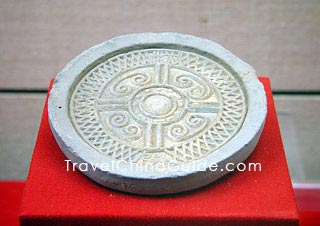 |
| Tile of Western Han Dynasty |
The Western Han Dynasty (206BC - 24AD) was regarded as the first unified and powerful empire in Chinese history. Lasting from 206 BC to 24 AD, it was established by Liu Bang, who became Emperor Gaozu following four years of civil war started by peasant uprisings against the despotic Qin Dynasty (221 - 207BC). Liu Bang recruited people based on their ability not birth or wealth, and his government included many former serfs and commoners. The capital city was named Chang'an (present day Xi'an). The dynasty based on a series of political and economic reforms, was ruled by 12 emperors in succession enjoying peace and prosperity.
Political History
The first emperor, Liu Bang, Emperor Gaozu initiated many effective measures by recruiting people for his government based on their ability, not birth or wealth, and drawing lessons from the collapse of the Qin and former dynasties. The economy recovered very quickly with able people in the government and with policies based on Lui Bang's reforms. The arts were encouraged by Gaozu and flourished. After Gaozu's death, his son Liu Ying succeeded to the throne although power was held by his mother Queen Lv Zhi. After 16 years of reign by Lv Zhi, Liu Heng (Emperor Wen) and Liu Qi (Emperor Jing) became the emperors in succession. They both reduced the people's tax burdens as Emperor Gaozu had done and encouraged the people to farm and be thrifty in life. Due to their effective measures, the people lived in stability and the nation's wealth and power were enhanced greatly.
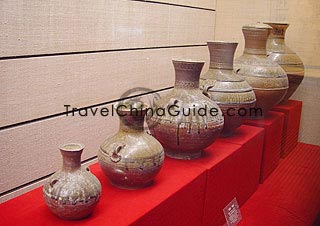 |
| Porcelain Jugs of Western Han Dynasty |
During the reign of Emperor Wu, Liu Che who ruled from 141 - 87 BC, the Han Dynasty achieved its most powerful and prosperous period. He dispatched two generals Wei Qing and Huo Qubing to fight against the Huns living in the north part of China and greatly enlarged the territory of the Western Han. Emperor Wu's wars assured safe trade routes and the establishment of the great Silk Road. Emperor Wu also sent emissaries and trade missions to many countries and established foreign trade. In his later years, through encouraging the development of agriculture, the economy developed quickly. Emperor Wu also changed the official state religion from Taoism to Confucianism. The eventual decline of the dynasty also began with Emperor Wu's policy of selling land to private landholders that would result in great inequality, raising taxes on the poor working people causing many people to be displaced and become serfs.
The dynasty passed its zenith under Emperor Zhao and Emperor Xuan who followed and Emperor Yuan (73 BC - 33 BC) began to lose the power to deal with the state affaires; going against the principle of promoting people based on ability, he had chosen prominent Confucians who relied on astronomy and fortune telling to fill government positions and as advisors.
The Western Han ended with Liu Ying and the country in revolution. Wang Mang seized the imperial throne (9 - 23) and changed the name of dynasty to Xin. However, after a series of protests the social rebellion became so serious that the rule of Wang Mang was overthrown by an uprising of peasants. This uprising was suppressed by Liu Xiu, (a royal of the Han) who was trusted by the people. In 25, Liu Xiu reestablished the Han Dynasty (now called Eastern Han) and made Luo Yang the capital city.
Economy
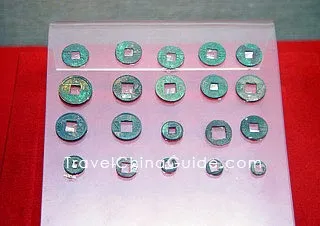 |
| Coins Inscribed with Characters "Wuzhu" or "Banliang" |
In agriculture, handicrafts, industry, and commerce there were great achievements.
In agriculture, water conservation and irrigation projects were built and greatly expanded production. Cattle, and iron farm tools were used at large to plough the land, and planting skills were also improved greatly so that one hectare of field could be seeded in a day.
Industry
In industry, productivity was improved greatly in both metallurgy and the textile industry. Looms were used taking the place of manual labor in weaving. Iron-smelting was carried on a large scale and steel was made using coal as fuel. Hydraulics were developed using water power to drive a celestial sphere.
Commerce
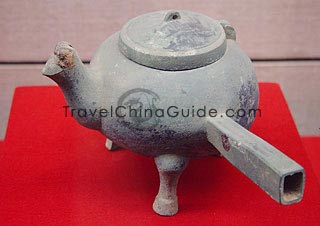 |
| A Wine Vessel with Loop Handle |
The stability of the country and rapid development of the arts with the invention of paper and porcelain and industry provided commerce a favorable environment to develop. Many commercial cities developed around the center of Chang'an. Not only domestic trade flourished but foreign trade prospered due to the opening up of the Silk Road. Diplomatic missions and trade were established with ancient Rome, India and many other countries.
Culture and Arts
Literature flourished with the invention of paper, as art flourished with the invention of the loom, and the invention of porcelain. The achievements of the Western Han had a profound influence on North Vietnam, and North Korea through the expansion of the empire, and on Japan through close trade ties.
From the reign of Emperor Wu, Confucianism became the main stream of thought in government. The phenomenon of letting a hundred schools of thought strive which was formed in the Spring and Autumn Period had disappeared. Henceforth, Confucianism became the philosophy for emperors in many dynasties to manage their state affairs.
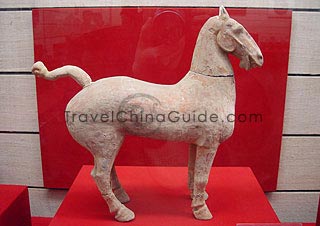 |
| Pottery Horse, Burial Object |
In literature, the great historian Sima Qian contributed to the Chinese historiography by writing the Book of History. It is the first chronicle of Chinese history (from Huangdi to Emperor Wu) and occupies an important status in the history and literature of China.
In art, the techniques developed in making porcelain were so superb that the level is comparable with that produced today. From excavated sites cultural relics continue to be unearthed that reveal the superb crafts of this period.
The earliest mathematical works were also created in the Western Han; and, astronomy was recorded in great detail including the mankind's first record of the solar system.
For more than 200 years, the Western Han was one of the most powerful countries in the world and its culture reached an unparalleled level.
The science and technology was in the leading position of the world. The world's first equipment to forecast the earthquake was invented during that period.